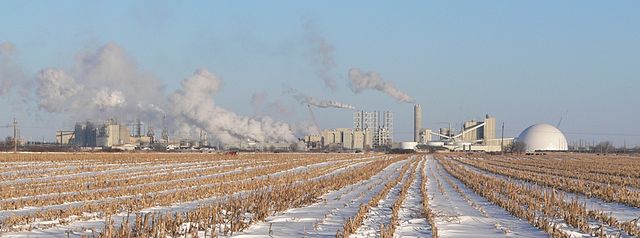Climate change may supercharge farm pollution
Photo courtesy of Wikimedia, Ammodramus
UN climate change report
The Intergovernmental Panel on Climate Change (IPCC) is the United Nations' body for assessing the science related to climate change.
Earlier this month, the IPCC reported that “rapid and far-reaching” changes are needed for global warming to be kept to a maximum of 1.5 degrees Celsius.
Even a half-degree more will significantly increase the risks of drought, extreme heat, coral die-offs and flooding along the coasts as well as rivers.
One specific impact we can anticipate: a stunning increase in pollution to the Mississippi River.
Climate, agriculture & water quality
Cropland is by far the largest source of pollution to our surface waters – especially nitrogen pollution. As demonstrated by the Minnesota Pollution Control Agency’s 2013 report on nitrogen in surface water, approximately 73% of nitrate pollution to Minnesota’s surface waters is from agricultural sources.
While many farm operations do their best to apply fertilizers efficiently, the “leaky” nature of our current crops (mostly corn and soybeans) means that protecting our water requires much more than just the most precise fertilizer application. That’s because heavily drained and tilled soils — left unprotected by growing vegetation for most of the year — are very prone to runoff.
Today, approximately 211 million pounds of excess nitrate flows downstream through the Mississippi River watershed annually from Minnesota. This not only harms local waters; it is the primary driver of the Gulf of Mexico Hypoxic Zone, a.k.a. the dead zone, which grew to record size in 2017.[1]
As climate change drives changes in precipitation patterns, new research indicates this problem may get a whole lot worse. A 2017 study in Science Magazine found that runoff pollution in the upper Mississippi River basin will increase by about 24% during the 21st century as a result of precipitation changes. Nationwide, the research predicts an overall increase in nitrogen pollution of 19%.
What this means for the future
Minnesota’s Nutrient Reduction Strategy calls for a 45% reduction in nitrogen pollution to the Mississippi River by 2040. This new research suggests that if we were to succeed, the benefit of that reduction would quickly be lost due to the impacts of changing climate and precipitation patterns.
As a result, it is more clear now than ever before: achieving clean water requires that we greatly reduce the greenhouse gas emissions that drive climate change.
Ready to make a difference?
Join the FMR River Guardians. We'll email you so you can act quickly online when the time is right. Plus you'll be invited to occasional special events like River Guardian happy hours.
Read more from The Water Blog
[1] Louisiana Universities Marine Consortium. Hypoxia in the Northern Gulf of Mexico. 2017.
